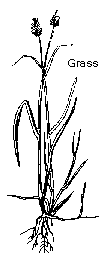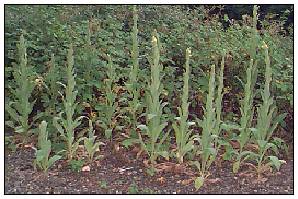 Medford Station 16: The Multipurpose Mullein
Medford Station 16: The Multipurpose Mullein
YOU CAN TELL BY THE DEBRIS caught in the willows next to the creek that flood water rises high here. The flood plain below is first invaded by grasses, which stabilize the silted banks. The willow shrubs are then able to take hold upon solid soil. They create the shelter necessary for alder and cottonwood saplings, which will become the dominant trees. Along the way, many grasses, herbs, and annuals migrate up the bank as the habitat changes. Eventually, the riparian zone becomes established, with its great variety of habitats that support a rich and stable population of plants and animals. The tall, spreading grass that seems to be everywhere is red fescue (Festuca rubra), a weed species. Here on the bank in front of you are the coarse, bunched quack grass (Agropyron repens) and mullein (Verbascun thapsus).
Mullein is a world traveler from Eurasia. Like the teasel, mullein is a biennial. The first year it grows a large rosette of soft woolly leaves. In its second year, mullein produces a prolific two-to-six-foot spike of yellow flowers, followed by thousands of seeds. It then dies back, leaving innumerable dead mullein stalks to stand as stark sentinels on desolate roadsides throughout the United States. Mullein has been used as a herbal cure for centuries. A tea was made from the flowers and used to treat coughs, congestion, and tuberculosis. At one time, mullein flowers were even smoked to sooth pulmonary disorders.



















